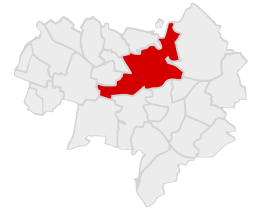Teichnitz
|
Teichnitz
Ćichońca City of Bautzen
Coordinates: 51 ° 11 ′ 47 " N , 14 ° 25 ′ 3" E
|
|
|---|---|
| Height : | 203 m |
| Area : | 7.15 km² |
| Residents : | 362 (Dec. 31, 2019) |
| Population density : | 51 inhabitants / km² |
| Incorporation : | July 1, 1950 |
| Postal code : | 02625 |
| Area code : | 03591 |
|
Location of Teichnitz in Bautzen
|
|
|
View from Oehna to the Bautzen dam
|
|
Teichnitz , in Upper Sorbian , is a place in East Saxony and has been part of Bautzen since 1950 . It consists of the incorporated villages Teichnitz, Neuteichnitz ( Nowa Ćichońca ), Neumalsitz ( Nowe Małsecy ) and Oehna ( Wownjow ) in the north of the urban area and has 367 inhabitants.
geography
The Teichnitz settlement is located about 2 km north of Bautzen city center, a little above the Temritzer Water, at an altitude of 190 m and directly on the Autobahn 4 . The Bautzen dam limits the district in the east . The districts of Oehna and Neumalsitz are located directly on the reservoir.
history
In the district of Teichnitz, traces of a Niederungsburg / Wasserburg from the 12th / 13th Discovered in the 19th century. The place was first mentioned in 1303 as the manor of Cuno de Thichenicz . Later it was the seat of various Upper Lusatian noble families, of which various manor houses bear testimony to this day. On July 1, 1950, Teichnitz was incorporated into the city of Bautzen.
Population and language
For his statistics on the Sorbian population in Upper Lusatia, Arnošt Muka determined a population of 182 in the 1880s, including 165 Sorbs (91%) and 17 Germans. Since then, the use of Sorbian has fallen sharply.
The "idol"
Near Oehna, not far from the district of Gesundbrunnen , is the Abgottschlucht, on the motorway bridge of A 4 on the Spree leads. In 1945 a previous bridge was blown up by German soldiers in the course of the Battle of Bautzen . When the bridge was built, parts of the Abgottfelsen on the west side and the Flinzfels on the east side were blown up. According to legend, a golden idol of the Sorbs , the "Flinz" or "Flins", should have stood at this point about a thousand years ago . Christian monks would have thrown him into the Spree in the course of Christianization . During archaeological investigations in the course of the motorway construction, the legendary gold treasures were not found, but medieval goblets and forks. Far more important, however, were the finds of canines from the peat cattle and peat pigs , the first domestic animals of the Neolithic Age . The shoulder piece of a woolly rhinoceros and skeletal remains of a reindeer and other large mammals were also discovered. These finds were significant evidence of the climatic theories of the post-ice age 15,000 years ago in Upper Lusatia , as they proved the presence of animals from the cold steppes.
Various legends about watermen in the region have also come down to us from the Oehna area.
Attractions
In 1303 the Teichnitz manor was first mentioned in a document. In 1463 it was a knight's seat and in 1607 a manor . The Barons von Gersdorff auf Teichnitz offered refuge there to religious refugees of the Moravian Brethren in the course of the Counter-Reformation in Bohemia and Moravia, who later founded the Kleinwelka colony . Around 1770 the manor was sold to the von Hohenthal family , who later rebuilt the manor house. Through the marriage of Countess Wilhelmine von Hohenthal with Count Friedrich zur Lippe-Biesterfeld-Weißenfeld (1737–1791), it came to the Lippe family in 1815 . Count Christian also acquired the Lubachau estate in 1829 ; furthermore, until the expropriation in 1945, the Gersdorf estates and - since 1901 - Proschwitz Castle were owned by the counts, who in 1918 were made princes of Lippe-Weißenfeld.
The Teichnitz manor house was built in its current form around 1730 on the foundation walls of an older manor house. The three-wing complex, designed as a plastered building, had no architectural decoration except for the apex stones above the portals. After the roof ledge on the north wing crashed in July 2013, the entire building complex was demolished in September 2013.
economy
Various production companies have set up shop in the Bautzen Nord industrial area on Neuteichnitzer Strasse, including an aluminum die casting foundry, a plastics plant and a SiC recycling plant. In addition, the Bautzen thermal power station had been located here since 1980 and was demolished in 2018. Its chimney was the tallest structure in the city of Bautzen. The former large farm in Oehna no longer exists.
literature
- Cornelius Gurlitt : Teichnitz. In: Descriptive representation of the older architectural and art monuments of the Kingdom of Saxony. 32nd issue: Bautzen Official Authority (Part II) . CC Meinhold, Dresden 1908, p. 296.
Web links
- Teichnitz in the Digital Historical Directory of Saxony
Sources and Notes
- ↑ As of December 31, 2017
- ↑ Ernst Tschernik : The development of the Sorbian population . Akademie-Verlag, Berlin 1954.
- ^ Friedrich Lehmann: Hiking trails through Upper Lusatia. VEB Domowina Verlag Bautzen, 1st edition 1981
- ↑ Teichnitz . In: Gustav Adolf Pönicke (Ed.): Markgrafenthum Oberlausitz (= album of the manors and castles in the Kingdom of Saxony . Volume 3 ). S. 133-134 .
- ↑ Free State of Saxony , State Ministry of the Interior : Particularly endangered cultural monuments in the Free State of Saxony: town houses, farmhouses , series of publications for building culture, architecture, monument preservation, series B, Bulletin 2, Dresden 1995, p. 114.




